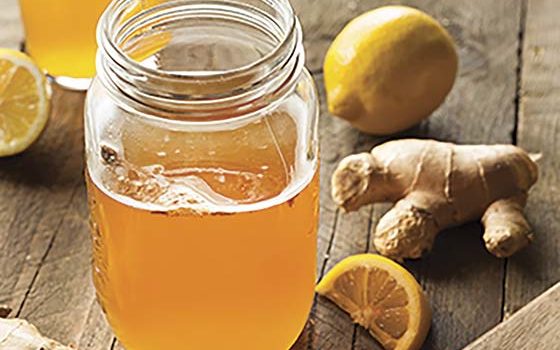A.k.a. the tea of immortality, kombucha is said to have come from China with earliest written references dating back to 221 B.C. Having gone mainstream a few years ago, kombucha can now easily be found in large supermarkets and local grocery stores. This fizzy beverage boasts 1,000 nutritional benefits and avid enthusiasts delight in all the flavours now available. Kombucha comes from the same family as fermented beverages that include kefir and can be described as a tart tea (made from black or green tea) that is fermented and effervescent thanks to the SCOBY bacteria (mother kombucha) used. Kombucha can be flavoured with herbs or fruits to your personal taste. For this recipe, we decided to go with a mint and chlorophyll kombucha for a refreshing finish. We figured it would be a great idea to serve as a cocktail for year-end festivities with the bubbles offering a festive touch, and the refreshing mint preparing the stomach for the Christmas feasting to come (also perfect as a digestif after the meal). With regards to the prep, it’s important to note that kombucha remains a traditional process since the SCOBY bacteria (symbiotic colony of bacteria and yeast) is a living organism, meaning no kombucha is ever the same – not from one manufacturer to another, nor from one batch to another, the result will always be different.
Benefits
Kombucha contains flavanoides, multiple enzymes, folic acid, acetic acid, gluconic acid, amino acids and vitamins B1, B2, B3, B6, B12, and C. Where to find the SCOBY bacteriaYou can find the kombucha mother in health stores, online, or through a friend who makes their own kombucha. Sharing and exchanging is also what I like about brewing your own kombucha. You can offer SCOBY to your friends so they can make their very own brew as well. If you don’t have the SCOBY, and can’t find any near you, simply take one or two bottles of store-bought kombucha, pour into a glass bowl, and cover with a nylon cloth and rubber band. Place the bowl in a dark, warm cupboard away from dust. Wait two to three weeks for a mother to grow on the surface of your bowl. I usually wait until it’s about a half centimetre thick before starting my own batch.
Hygienic considerations
As with all fermented food preparations (sauerkraut, kimchi and so on), preparing kombucha requires following very strict hygiene rules. Make sure to properly sterilize all objects that will come into contact with the kombucha in boiling water beforehand. Wash your hands before touching the mother bacteria and rinse them properly since the mushroom doesn’t respond well to soapy residue. Don’t forget to cover the bowl with a clean breathable cloth: the cloth protects the inside of the bowl from outside contaminants such as dust and small insects (especially in summer).
Choice of ingredients
It’s important to use ingredients that you’re familiar with and enjoy, especially for the tea. Choose a tea you usually drink with a taste you already like. For the liquid chlorophyll, I buy the local brand Land Art since it’s free of GMOs, contains no preservatives and is made right here! The benefits of kombucha pair delightfully with those of the chlorophyll, which serves as a detox, antioxidant and alkalinizing agent. Ready to give it a go? Take a look at this feature to make your own DIY mint, ginger and chlorophyll kombucha in 6 easy steps!
Audrey Sckoropad

